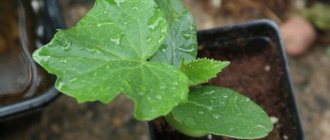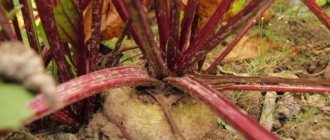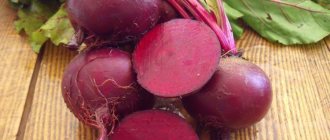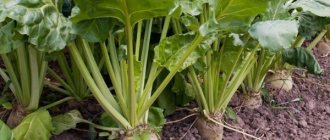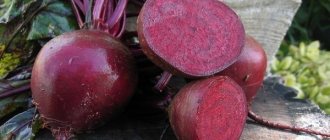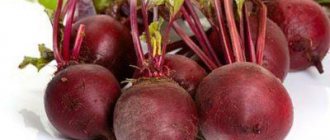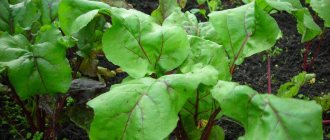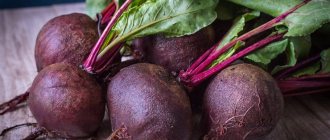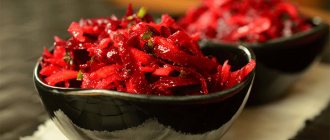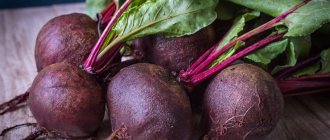In this article we will talk about one of the most popular plants in the garden: the Detroit table beet, a description of the varieties of which we present to the attention of readers.
Detroit beets (pictured) belong to the category of the most popular table varieties with small rounded roots
"Detroit" is a variety of beet that produces small, round-shaped roots that are highly valued by gardeners. As a rule, when growing this variety there are no problems with compacted plantings, the crop is easy to harvest, and quite simple to store and process.
History of the variety
This variety was bred by breeders from Italy. Currently, there are several varieties of Detroit beets with similar parameters. They differ only in the size of the root crops, different shades of color of the skin and pulp. Only two varieties are included in the Russian State Register: Detroit and Detroit ruby 3.
This article will talk about the first and most popular variety of this root vegetable, which was included in the Russian State Register in 1997.
Reproduction
Beets are planted with seeds or seedlings, but if you plant seedlings, they get sick more often and are more sensitive to temperature fluctuations.
Seed preparation options:
- Soak the seeds in warm water for a day; the water needs to be replaced 2-3 times. Afterwards the seeds are dried.
- Place a rag soaked in water in a saucer in two rows. Place 50-100 seeds on it and cover them with another damp cloth. The saucer is placed in a warm place, the air temperature should be 18-25 ° C. The cloths should be damp. After 4 days, the seeds are planted in well-watered soil.
- Seeds for vernalization are placed in an enamel pan at a depth of 3-4 cm and filled with 50 g of water, and after 32 hours another 50 g is added. Afterwards, the seeds should germinate at a temperature of 15-20 ° C, they are covered with a damp cloth so that it does not touch the and mix it. They are left like this for 2-4 days. Then the seeds are poured into a box in a layer of up to 3 cm and placed in a cold room for 10 days.
- It is necessary to make furrows with a distance of 20-25 cm.
- Seeds are planted every 15 cm.
- Water and cover with 3 cm of soil.
- Then mulch with peat or vermiculite.
- The first shoots appear after 5-6 days at an air temperature of 4-5°C.
It is recommended to mix beet seeds with spinach seeds when sowing, as many weeds can grow that will interfere with the growth of beets. When the first beet shoots appear, the spinach is removed or left for a month. Afterwards it is collected.
Detroit beets: characteristics and description of the variety
Detroit beets belong to the mid-early type.
according to the ripening time of root crops - from the moment the sprouts appear until the harvest, a little more than 3 months pass. The shape of the leaf rosette is semi-erect. The foliage is of medium length, oval in shape, dark emerald color with dark red veins. The petioles are medium in size, rich red in color.
The shape of ripe Detroit beetroots is round, even, and the harvested crop is approximately the same size. The color of the dense skin is red, the color of the sweetish dense pulp is dark red. There are no light rings or hard fibers in the beet cut. The weight of the collected root crops is 120-205 g.
100 g of fruit contains 17.8-20.3% dry matter and up to 12.4-14.1% total sugar.
The harvested crop tolerates transportation well over long distances; root crops are suitable for long-term storage in appropriate conditions. Root vegetables are distinguished by their versatility of use - they are used in the preparation of hot dishes, salads, snacks; ripe beets make delicious sweet juice and winter preparations.
Consumer qualities
Root crops of all varieties of the Detroit variety have a round, almost spherical shape. The central root is thin and short. Vegetables are uniform in size, rarely become small and do not grow too large. The average weight of 1 root vegetable is 150-200 g.
The average yield reaches 5-7 kg per 1 m². Detroit beets bear fruit consistently if the rules of agricultural technology are observed in any climatic conditions.
The skin covering the root crops remains soft when technically ripe, so young beetroot is only thoroughly washed before use. As it ripens, the rind hardens and becomes inedible. When consumed, it is cut off with part of the pulp. But the rough skin of mature beets serves to preserve the vegetable from withering in winter. Thanks to its density, Detroit beets can remain in a cold cellar until almost the new harvest.
Detroit beets have gained great popularity for their high yield, taste and excellent appearance. The variety is unpretentious to growing conditions and requires minimal care. The description and characteristics of this variety are given below.
Diseases and pests
Although the originators of the variety claim that Detroit beets are highly resistant to most diseases, there are a number of diseases that can damage the above-ground parts and root crops, as well as a number of pests that also damage the crops of this vegetable crop.
The most dangerous diseases and pests of the Detroit variety are:
- white and gray rot - damage the root collar and lower leaves of the rosette;
- downy mildew - can develop on the tops;
- mole cricket - during spring and early summer it is a scourge of vegetable crops, feeding on roots and stems of beets and other plants, which can cause the death of plants;
- winter cutworm - these caterpillars gnaw at young seedlings, destroy tops, and spoil growing root crops.
Photos of Detroit beets
Prevention of various problems
Most often, gardeners encounter the following problems:
- Long tops and small root crops indicate a lack of light.
- Reddish spots and black dots on the leaves (fomosis) are due to a lack of boron.
- Thin long root vegetable. The plants were not thinned out enough.
- Death after thinning is associated with damage to the root structure. For prevention, it is necessary not to pull out the plant, but to trim its tops.
- If all the rules are followed, and the beets are often sick, you should try winter planting.
By choosing the Detroit variety for planting, you will receive a large number of tasty, well-preserved fruits, suitable for use for any purpose. And at the same time you won’t have to spend a lot of effort caring for the plant.
If you find an error, please select a piece of text and press Ctrl+Enter.
Detroit beets: agricultural technology for growing
In most regions, it is recommended to plant seed material from the second ten days of April. Areas for planting are prepared in advance; in the fall, humus or rotted compost is added for digging. In the spring, grooves are made in the beds, the distance between which should be at least 0.2 m. Beet seeds are placed at the bottom of such trenches.
At the stage of two permanent leaves, the crops should be thinned. In the future, it will be necessary to carry out another thinning so that the distance between neighboring seedlings is at least 8 cm.
Although this beet variety is resistant to short periods of drought, in hot, dry summers these vegetable plants should be watered at least once every 3 days, and then loosen the soil around the plants.
The best means for feeding Detroit beets are organic fertilizers: manure, chicken droppings and wood ash. These fertilizers should be applied in the fall. For feeding in the spring, liquid infusions based on these organic matter should be prepared. You can also use complex mineral fertilizers.
Important!
Do not add fresh manure or bird droppings to the crops of this vegetable plant - this can damage the growing root crops.
When planting beets in beds, you should follow the rules of crop rotation. The best predecessors for this vegetable crop are cucumbers, early potatoes, tomatoes or onions.
The soil acidity level should be neutral, since this vegetable plant is sensitive to increased soil acidity and grows worse in such soils. If the soil is too acidic, then chalk or lime should be added to the soil in the fall.
Planting seeds
This variety grows well both when grown in seedlings and directly in open ground. Planting beets with seedlings makes it possible to get a harvest much earlier, but at the same time the young plant needs to be created with comfortable conditions and proper care.
Beet seeds should be soaked before planting.
Rules for planting seeds in open ground:
- The root crop is sown in previously prepared nutrient soil. In autumn, the soil is dug up using a spade and fertilized with organic and mineral fertilizers.
- a place for growing beets that is sunny and protected from drafts.
- The ideal place is considered to be the beds where cucumbers, tomatoes, potatoes or onions used to grow , but where cabbage and carrots grew, it is not suitable for root vegetables.
- If the soil is highly acidic, ash or lime is added to it.
- Seeds are sown in the beds when the ground warms up to 10-13 degrees .
Two ways to prepare seeds:
- Before planting, beet seeds are soaked in warm water for 24 hours, while constantly changing the water.
- The seeds are wrapped in a cloth soaked in a weak solution of potassium permanganate and left in a warm place for 4 days. It is necessary to ensure that the fabric is not very wet, but is constantly damp.
Planting seeds:
Beet seeds have the ability to stick together. If such seeds are found, you should not try to separate them, as this can cause irreparable harm to the planting material.
Detroit beets: reviews from those who planted
Below are some of the reviews from vegetable growers about the Detroit beet variety:
Tatyana, 39 years old:
“For many years now I have been growing different varieties of beets in my garden, trying to choose the most productive variety with a long shelf life of the harvested crop. A couple of years ago, a salesman advised me to plant Detroit beets in my garden beds. I really liked this variety - high yield, medium-sized root crops - sweet, juicy, and can be stored for a long time in appropriate conditions. And growing them is not too difficult.”
Natalia, 50 years old:
“I have been growing Detroit beets for several years now, as this root crop ripens in just 3 months, does not require special care, is not affected by diseases, and is stored for a long time. In a word, I now recommend this variety of beets to all my neighboring summer residents.”
Svetlana, 44 years old:
“I decided to try planting beets in my garden before winter. I was recommended to try the Detroit variety. I took a chance and sowed a bed of these root crops in early November, almost before the frost. In the spring, these vegetable plants sprouted soon after the snow melted. As an experiment, I planted another bed of Detroit beets in the spring. So those seedlings that were planted before winter grew and produced a harvest several weeks earlier than in the bed where the seeds were planted in the spring. All root vegetables are approximately the same size, have a sweet taste for beets, and their keeping quality was excellent.”
Harvesting
Detroit beets, bred in Italy, have very high yields and excellent taste. Root vegetables have many beneficial properties.
The last ten days of September is the optimal time for mass harvesting of beets. At this time, the root crops are already fully ripened and of the highest quality. Harvested on time, the harvest will be perfectly preserved throughout the winter period. Dig
Read more: Snow white plum variety description
roots
necessary in dry weather, which makes it possible to carry out high-quality drying of the crop before storing it.
Beetroot of the Italian selection of the Detroit variety is very undemanding to storage conditions.
The last ten days of September is the optimal time for mass harvesting of beets. At this time, the root crops are already fully ripened and of the highest quality. Harvested on time, the harvest will be perfectly preserved throughout the winter period. It is necessary to dig up root crops in dry weather, which makes it possible to carry out high-quality drying of the crop before storing it.
Beetroot of the Italian selection of the Detroit variety is very undemanding to storage conditions.
Harvesting can be done at the end of August or early autumn. It is best to do this on a dry, sunny day. It is recommended to send root vegetables for storage after they have dried in the sun.
